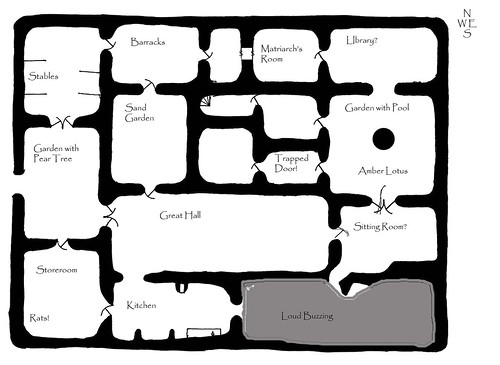
I'm hoping that clicking on the image above will allow you to get a larger version that's actually legible. Yeah, it's ugly, a hand-drawn map scanned and edited with my meager Photoshop skills. I'm certainly not using it to advertise my capabilities as a cartographer. ;p
This is the Villa of the Poyma, an ancient elven clan. The building's been abandoned for over 700 years now, with intermittent habitation by orcs and goblins. Otherwise, it's become the home of various less-than-sentient monsters, including rats in the storeroom (bottom southwest corner), bats in the armoury (just east of the barracks, the little room with the secret connecting passage), a pair of tarantella (tarantellas? tarantelli?), and mystery creatures that are buzzing very loudly in the unexplored area east of the kitchen.
Ugly as the map is, it's a good example of my design philosophy for dungeons. This place was built to be lived in, not as a challenge for adventurers. It was a functioning home and center of operations for an influential family who were leaders in their community. The single entrance in the western wall brings you into an audience garden, where the matriarch of the family or her stand-in would greet clients, debtors, and petitioners on a regular basis. Many of these would bring gifts or payments, usually in the form of goods the household needed. So a farming family might bring milk from their cow every morning as part of the tuition they owed the family for a son attending the family school. Non-perishables would be kept in the storeroom directly south of the garden. Just north of the garden are the stables, where the riding beasts were housed. The large doors in the eastern wall of the garden open directly into the great hall, where the family would hold parties and feasts. The kitchen is directly south of the great hall and east of the storeroom, convenient to both.
You can see how this style of designing makes it easy to fill up your graph paper. One area flows naturally into the next, because lived-in locations have their own logic. It's a great way to get started if you find a blank page daunting. If you know who built a place and why, you can then begin to shape it based on those assumptions. Later inhabitants will then move in and put their own mark on the place. You can build a ruin in layers like this.
This particular villa was also built in zones. The western-most rooms are all about coming and going: audience garden, stables, and warehouse. North of the great hall are the barracks and "sand garden" (for sparring and training) of the guards/mercenaries. The small room with the secret door to the east of the barracks was their armoury. The secret passage allowed the guards to get quickly to the matriarch's chambers, and also allowed her to get inside the armoury and lock it from the inside if she feared mutiny. The southern portion of the map was the servants and slaves territory, including the kitchen and storeroom. I doubt I'm giving too much away when I say that the rooms beneath the "fog of war" were more barracks and workrooms for the family's slaves. Finally, the eastern portions of the map were the private areas enjoyed by the family. Knowing all this helps when coming up with descriptions. The finest furnishings and fixtures are found in the family's dwelling rooms, while the rudest and most utilitarian are found in the slave quarters.
After I knew how the Poyma used and lived in the villa, I could then add the layers of years since they fled: orcish graffiti gouged into the pear tree in the audience garden, the detritus of the goblin spider-hunters' camp in the old guard barracks, the wounded carvings and doors where gems and gilding have been plundered.
There are a few old school touches here and there. For instance, while the villa has only one "official" entrance, the first room that entrance opens into offers multiple paths for exploration. The entire place is a bit of a circle, and after exploring for a bit, the players can then pick-and-choose which challenges they feel up to tackling.





4 comments:
Quite an achievement Trollsmyth. All these subtle and complex demands of designing a locale with some sense of verisimilitude, carefully balanced against the most ancient and universal law of gamer mapping:
"It must fit near-perfectly on a single A4 sheet" ;-)
LOL! Very true!
I actually use the rule to rein me in. I could easily have made this place four times its current size, but that would have been insane, especially since the game is played via chat and so a bit slower than face-to-face. So yep, I try, when possible, to keep each level to a single sheet and, when necessary, jigger the scale one way or another.
Sweet. Don't worry about your mapping skills; you're much much better than I am! ;3
Not from what I've seen.
Yes, I know that one was drafted with the help of a computer. So was mine. ;p
Post a Comment